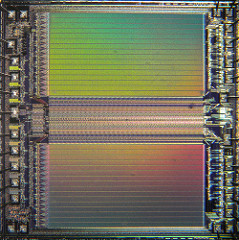Decipher Chip Microchip PIC17C756A

Decipher Chip Microchip PIC17C756A
We can Decipher Chip Microchip PIC17C756A, please view the MCU IC features for your reference:
Microcontroller Core Features:
· Only 58 single word instructions to learn
· All single cycle instructions (121 ns) except for program branches and table reads/writes which are two-cycle
· Operating speed:
– DC – 33 MHz clock input
– DC – 121 ns instruction cycle
· 8 x 8 Single-Cycle Hardware Multiplier
· Interrupt capability
· 16 level deep hardware stack
· Direct, indirect, and relative addressing modes
· Internal/external program memory execution, Capable of addressing 64K x 16 program memory
Special Microcontroller Features:
· Power-on Reset (POR), Power-up Timer (PWRT) and Oscillator Start-up Timer (OST)
· Watchdog Timer (WDT) with its own on-chip RC oscillator for reliable operation
10-bit, multi-channel analog-to-digital converter
High current sink/source for direct LED drive
Four capture input pins
– Captures are 16-bit, max resolution 121 ns
Three PWM outputs (resolution is 1- to 10-bits)
TMR0: 16-bit timer/counter with
8-bit programmable prescaler
TMR1: 8-bit timer/counter
TMR2: 8-bit timer/counter
TMR3: 16-bit timer/counter
Two Universal Synchronous Asynchronous
Receiver Transmitters (USART/SCI) with Independent baud rate generators
Synchronous Serial Port (SSP) with SPI™ and I2C™ modes (including I2C master mode)
· Brown-out Reset
· Code-protection
· Selectable oscillator options
CMOS Technology:
· Low-power, high-speed CMOS EPROM technology
· Fully static design
· Wide operating voltage range (3.0V to 5.5V)
· Commercial and Industrial temperature ranges
– < 5 mA @ 5V, 4 MHz
– 100 µA typical @ 4.5V, 32 kHz
– < 1 µA typical standby current @ 5V
A highly reliable Watchdog Timer with its own on-chip
This data sheet covers the PIC17C7XX group of the PIC17CXXX family of microcontrollers. The following devices are discussed in this data sheet:
· PIC17C752
· PIC17C756A
· PIC17C762
· PIC17C766
The PIC17C7XX devices are 68/84-pin,
EPROM-based members of the versatile PIC17CXXX family of low-cost, high-performance, CMOS, fully-static, 8-bit microcontrollers. All PICmicro™ microcontrollers employ an advanced RISC architecture. The PIC17CXXX has enhanced core features, 16-level deep stack, and multiple internal and external interrupt sources. The separate instruction and data buses of the Harvard architecture allow a 16-bit wide instruction word with a separate 8-bit wide data path. The two stage instruction pipeline allows all instructions to execute in a single cycle, except for program branches (which require two cycles). A total of 58 instructions (reduced instruction set) are available.
Additionally, a large register set gives some of the architectural innovations used to achieve a very high performance. For mathematical intensive applications all devices have a single cycle 8 x 8 Hardware Multiplier. PIC17CXXX microcontrollers typically achieve a 2:1 code compression and a 4:1 speed improvement over other 8-bit microcontrollers in their class. PIC17C7XX devices have up to 902 bytes of RAM and 66 I/O pins. In addition, the PIC17C7XX adds several peripheral features useful in many high performance applications including:
RC oscillator provides protection against software malfunction. There are four configuration options for the device operational mode:
· Microprocessor
· Microcontroller
· Extended microcontroller
· Protected microcontroller
The microprocessor and extended microcontroller modes allow up to 64K-words of external program memory.
The device also has Brown-out Reset circuitry. This allows a device reset to occur if the device VDD falls below the Brown-out voltage trip point (BVDD). The chip will remain in Brown-out Reset until VDD rises above BVDD.
A UV-erasable CERQUAD-packaged version (compatible with PLCC) is ideal for code development while the cost-effective One-Time Programmable (OTP) version is suitable for production in any volume. The PIC17C7XX fits perfectly in applications that require extremely fast execution of complex software programs.
These include applications ranging from precise motor control and industrial process control to automotive, instrumentation, and telecom applications. The EPROM technology makes customization of application programs (with unique security codes, combinations, model numbers, parameter storage, etc.) fast and convenient.
Small footprint package options (including die sales) make the PIC17C7XX ideal for applications with space limitations that require high performance.
High speed execution, powerful peripheral features, flexible I/O, and low power consumption all at low cost make the PIC17C7XX ideal for a wide range of embedded control applications.
Three PWM outputs
Two independent Universal Synchronous Asynchronous Receiver Transmitters (USARTs)
· An A/D converter (multi-channel, 10-bit resolution)
· A Synchronous Serial Port
(SPI and I2C w/ Master mode)
These special features reduce external components, thus reducing cost, enhancing system reliability and reducing power consumption. The PIC17CXXX family of microcontrollers have architectural enhancements over the PIC16C5X and PIC16CXX families.
These enhancements allow the device to be more efficient in software and hardware requirements. Refer to Appendix A for a detailed list of enhancements and modifications. Code written for PIC16C5X or PIC16CXX can be easily ported to PIC17CXXX devices (Appendix B).
There are four oscillator options, of which the single pin RC oscillator provides a low-cost solution, the LF oscillator is for low frequency crystals and minimizes power consumption, XT is a standard crystal, and the EC is for external clock input. The SLEEP (power-down) mode offers additional power saving. Wake-up from SLEEP can occur through several external and internal interrupts and

